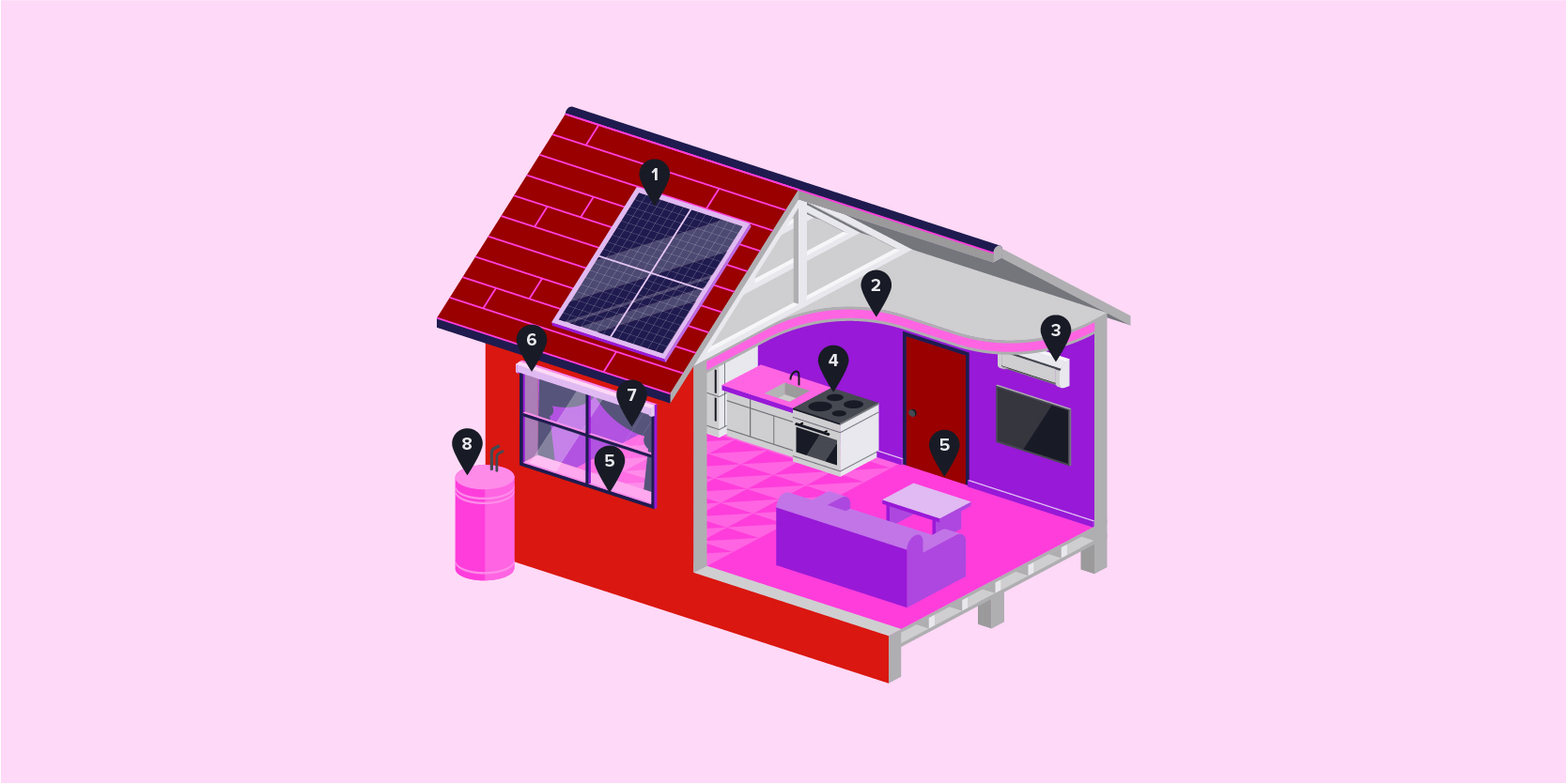Budget-Friendly Home Upgrades to Improve Energy Efficiency: Ella’s Story
Ella recently bought her dream home, a charming fixer-upper in the suburbs. Recognising that she wanted to make her home more energy-efficient, Ella took the initiative to improve it. She began by tackling some of the initial steps herself and then enlisted qualified tradespeople to handle the rest. Her goal was to lower energy bills, reduce carbon emissions, and enhance comfort levels through budget-friendly renovations.
After reading the Green Building Council of Australia’s (GBCA) Guide to Sustainable Home Renovations, Ella learned that energy-saving practices could reduce utility costs and emissions. In Australian homes, heating and cooling typically consume the most energy. Water heating, appliances, lighting, cooking, and standby power follow closely. Ella concentrated on modest, cost-effective solutions to boost energy efficiency and reap the benefits.

* This story and the name used in it are for illustrative purposes only and is not based on any one individual.
Any savings claims made in this article are general in nature and based on theoretical research findings. Actual costs and bill savings will depend on a range of factors including (but not limited to) location, property, system components, weather, energy consumption and feed-in tariffs.
Understanding the Benefits
Ella found out that a range of renovations could help her save money on her energy bills. Research findings in the 2023 Climate Ready-Homes Report by Climateworks Centre, indicates that ‘quick-fix’ home upgrades are largely cost effective for households. By focusing on budget-friendly renovations and energy-saving tips, Ella aimed to maximise her investment and achieve long-term cost savings.
She allocated a budget for the sustainable home upgrades and concentrated on cost-effective solutions. To plan her upgrades, she used resources like the Federal Government’s energy guidance for households, the YourHome site and the GBCA Guide to Sustainable Home Renovations which led her to develop an 8-step home renovation plan.
- Step 1: Identifying and Sealing Air Leaks
- Step 2: Insulating the House
- Step 3: Upgrading Windows and Coverings
- Step 4: Improving Heating and Cooling Efficiency
- Step 5: Upgrading Hot Water System
- Step 6: Upgrading Cooking Appliances and Electrifying Her Home
- Step 7: Installing Solar Panels
- Step 8: Leveraging Government Grants and Rebates
Step 1: Identifying and Sealing Air Leaks
Ella's house was draughty, allowing cold air to seep in during winter and hot air to infiltrate in summer, resulting in an uncomfortable living environment and raising her heating and cooling expenses. Sealing these gaps could enhance thermal comfort, energy efficiency and acoustics.
Steps Taken:
Ella addressed air leaks by following instructions from the GBCA’s Guide to Sustainable Home Renovations. The practical steps she followed could potentially save on heating and cooling costs. The first of many energy-efficient quick-wins to come on this renovation project.
- Windows and Doors: Ella used self-adhesive weatherstrips to seal gaps around doors and windows and installed draught excluders at the bottom of external doors.
- Sealing Gaps: Ella used flexible caulking for small cracks and expandable foam fillers for larger holes. She sealed cracks around door and window frames, architraves, skirting boards, and other joints. She also sealed her unused fireplace to reduce air leakage and draught stoppers over her existing exhaust fans.
Step 2: Insulating the House
Ella learned that insulation is crucial for keeping her house warm in winter and cool in summer, reducing her reliance on heating and cooling systems, resulting in cost savings and improving the comfort of her home.
Steps Taken:
Before engaging suppliers and installers, Ella using guidance from the GBCA’s Guide to Sustainable Home Renovations and the Federal Government’s YourHome Guide, to understand how home insulation could save energy to heat and cool her home, helping her save money on her energy bills and maintain a comfortable temperature year-round.
- Understanding and Choosing Insulation Types: Ella learned about different types of insulation, including bulk insulation like glasswool (fiberglass), which traps air to block heat, and reflective insulation that bounces heat away. She chose glasswool insulation, with a high R-value (R-values indicate how effective insulation is at stopping heat flow).
- Installing Ceiling Insulation: The installers ensured there were no gaps or squashed areas that would reduce effectiveness. Also, they maintained good ventilation to avoid moisture problems and left space around electrical fixtures to prevent fire hazards.
Step 3: Upgrading Windows and Coverings
Ella understood from the YourHome Guide that her old single-pane windows caused heat gain in summer and heat loss in winter, making her home uncomfortable and inefficient. Improving the windows' thermal performance would be crucial for energy-efficiency.
Steps Taken:
- Installing Heavy Curtains: Ella installed heavy curtains with pelmets, which are boxes above curtains that block draughts. They help retain warmth in winter and block heat from the sun in summer.
- Using External Roller Shutters: She engaged a qualified tradesperson to install external roller shutters for windows facing east and west to block direct sunlight, keeping her house cooler in summer and adding another layer of energy-efficiency.
Step 4: Improving Heating and Cooling Efficiency
Ella's old gas space heater is energy inefficient and costly to run. Having considered the GBCA’s guidance on transitioning from gas, she planned to replace her space heater when it stops working, with an energy-efficient reverse cycle air conditioner.
Steps Taken:
- Switching to a Reverse Cycle Air Conditioner: Ella decided to replace her old gas heater with a reverse cycle air conditioner, as it would not only heat her home in winter but also cool it in summer. According to the YourHome.gov.au, reverse cycle air conditioners are the most energy-efficient combined heating and cooling system to buy.
- Choosing a High Star Rating System: Ella chose a model with a high energy efficiency star rating. She understood that the more stars on the Energy Rating Label, the less energy her product would use and the more money she would save on her energy bills.
- Replacing at the End of Life: By replacing old, energy-inefficient systems at end of their life cycle, Ella can undertake a budget-friendly renovation. By allocating funds for this transition, she can prepare for the larger upfront investment and reap the benefits of operational cost savings by adopting energy-efficient electric alternatives.
Step 5: Upgrading Hot Water System
Ella discovered that heating water for showers, baths, and washing clothes is the second largest contributor to the average home’s energy consumption1. She found that a more energy-efficient system, like an electric heat pump or solar boosted system, would be more cost-effective to operate compared to her current gas hot water system. Despite its higher initial purchase costs, compared to alternatives systems, she was pleased to find out that local government energy-saving incentives may be available to reduce the overall expense.
Steps Taken:
As a part of her budget-friendly renovations plan, Ella considered her options and decided to replace her old gas water heater when it stopped working with an electric heat pump water heater.
- Choosing an Electric Heat Pump Water Heater: After careful consideration, Ella decided to purchase an electric heat pump water heater – and was happy she had read about this great energy saving tip. These heat pumps outperform traditional gas or electric water heaters, by efficiently transferring heat from the air to warm the water, which uses less energy. The GBCA Guide to Sustainable Home Renovations recommends a Coefficient of Performance for heat pumps of 4.0, indicating high energy efficiency and resulting in lower energy bills.
- Replacing at the End of Life: Instead of just getting another gas water heater, Ella chose the more efficient heat pump water heater when her old system needed to be replaced.
Step 6: Upgrading Cooking Appliances and Electrifying Her Home
Ella learned that upgrading her cooking appliances and moving towards electrification was a cost-effective solution that could make her home more energy efficient.
Steps Taken:
- Switching to Induction Cooking: Ella replaced her old gas cooktop with an induction cooktop, which heats pots and pans directly, making cooking faster and more energy efficient.
- Electrification of the Home: After Ella had replaced her old gas appliances with energy-efficient electric ones, she closed her gas account to eliminate the gas supply charge. She followed tips from the GBCA Guide to Sustainable Home Renovations.
Step 7: Installing Solar Panels
Ella found out that solar panels are a cost-effective way to reduce electricity bills and reliance on the main power grid.
Steps Taken:
- Evaluating Solar Potential: Ella assessed her home’s solar potential using the online tools in the Solar Consumer Guide.
- Installing Solar Panels: She consulted solar professionals and installed a basic solar PV system without battery storage. She selected an affordable yet efficient system to maximize energy production.
Step 8: Leveraging Government Grants and Rebates
Ella discovered that government grants and rebates could make energy-efficient upgrades more affordable by reducing upfront costs.
Steps Taken:
- Researching Programs: Ella visited the Federal Government’s Rebates and Loans for Solar and Rebates and Assistance pages to find information on available incentives for solar panels, heat pumps, and other energy-saving tips.
- Applying for Rebates: Ella’s suppliers applied on her behalf for rebates for the solar panels and electric heat pump water heater, successfully reducing Ella’s installation costs.
Ella’s Results
Ella's journey to make her old home more energy-efficient demonstrates how budget-friendly renovations could improve comfort and sustainability. By addressing key areas on a budget, she achieved some great results. By Ella sealing air leaks, improving insulation, upgrading windows, enhancing heating and cooling systems, switching to energy-efficient appliances, and installing solar panels, she not only saved money on her energy bills but also reduced her carbon footprint.
Ella’s approach included consulting the GBCA Guide on Sustainable Home Renovations, YourHome Guide, and the Solar Consumer Guide. Additionally, government grants and rebates helped lower the financial costs of making changes to her home.
Ella's story underscores that with proper planning and access to resources, homeowners can potentially enhance their energy-efficiency, even on a budget.
Unlocking Energy Savings for Your Home
By embracing energy-efficient home upgrades and purchasing energy-saving appliances, you could lower your energy bills. Renewable energy solutions, equipment upgrades, and insulation improvements could help homes use less energy and maintain a comfortable temperature. The Sustainable Upgrades home loan offered by Westpac, could help you to fund some of these energy-efficient home upgrades.

| Element | Location |
|---|---|
| 1. Solar panels | Roof |
| 2. Ceiling insulation | Ceiling |
| 3. Reverse cycle air conditioner | Living area |
| 4. Induction cooktop | Kitchen |
| 5. Draught proofing | Around windows, doors & skirting boards |
| 6. Roller shutters | Windows |
| 7. Heavy curtains | Windows |
| 8. Hot water heat pump | Outside |
Find out more information from the Green Building Council of Australia's Guide to Sustainable Home Renovations.
1 Energy.gov.au. Hot water systems. Accessed July 31, 2024.
Things you should know
Conditions, credit criteria, fees and charges apply. Residential lending is not available for Non-Australian Resident borrowers.
This information is general in nature and has been prepared without taking your objectives, needs and overall financial situation into account. For this reason, you should consider the appropriateness of the information and if necessary, seek appropriate professional advice. This includes any tax consequences arising from any promotions for investors and customers should seek independent, professional tax advice on any taxation matters before making a decision based on this information.